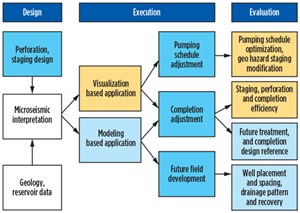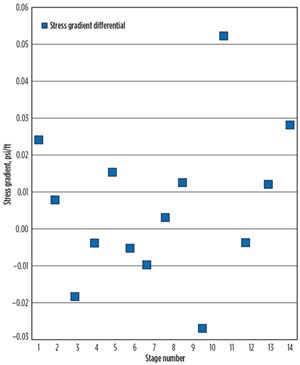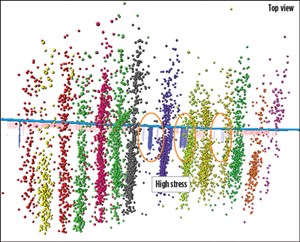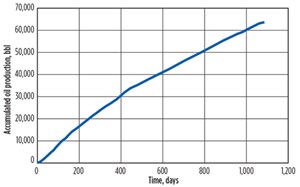Integrated workflow optimizes completion, boosts production in Chinese tight oil well
China’s unconventional basins hold significant quantities of in-place oil and gas, but they have been largely underdeveloped, due to technical limitations in overcoming challenging reservoirs and geology. Tight oil reservoirs, featuring thin pay zones and low permeability and porosity, have historically yielded low or poor production using conventional exploration and appraisal practices. Unlocking production in these plays requires tools and technologies that go beyond standard methodologies.
Over the past decade, technological advances have enhanced the industry’s ability to tap the potential of unconventional plays, both in North America and emerging markets, such as China. An important turning point was the realization that the heterogeneity and complexity of unconventional formations require detailed reservoir understanding. They also required the application of a disciplined and integrated workflow that can simulate or model hydraulic fractures to optimize the completion program.
China’s biggest oil production company, PetroChina, teamed up with Schlumberger to successfully use the Mangrove engineered stimulation design in the Petrel platform software to design a completion for a multi-stage horizontal well in north-central China’s Ordos basin. This is China’s second-largest, onshore producing basin, spanning an area of 370,000 km2 across parts of Shaanxi, Shanxi and Gansu provinces, and the Ningxia Hui and Inner Mongolia regions. The application of a real-time, microseismic fracture monitoring tool further optimized the design and treatment execution. The integrated approach resulted in a more than eight-fold production increase, compared to conventionally completed vertical wells.
The NP1 well is in the unconventional, oil-rich Chang 7 reservoir, underlying conventional oil layers in the Ordos basin’s Yanchang formation. The sandstone reservoir has stacked sand and shale deposits resulting from a series of river, delta and lake systems deposited during the Triassic period. The low-porosity, low-permeability layers feature reservoir-quality factors that include high quartz content, fine grain size, and depositional microfacies and diagenesis. The lateral extension of the formation is uniform with extensive areal distribution. It is divided into three oil layers, with the Chang 7-1 identified as the primary target zone.
Exploration and development in the Chang 7 formation began in 1996. Initial exploration and appraisal efforts involved drilling multiple vertical wells to characterize the reservoir, using core data, field observations, and analysis and seismic sequence interpretation. To improve production performance in the sands, operators began drilling and completing a large number of vertical wells, typically with a small, single hydraulic fracturing stage, and a treatment consisting of 100,000 lb/m to 250,000 lb/m of proppant and a hybrid fracturing technique.
In some cases, initial production (IP) rates showed marginal improvement, with output ranging from 30 bopd to 150 bopd. However, IP rates tended to decline significantly within the first three to six months. The large number of vertical wells provided offset correlations for subsequent horizontal well development. Wells typically were designed with several transverse hydraulic fracturing treatments to establish more reservoir contact and achieve commercial flowrates.
FIT-FOR-PURPOSE COMPLETION STRATEGY
In a pilot project aimed at optimizing production in the NP1 well, PetroChina implemented the Mangrove engineered stimulation design (MESD) software, which incorporates reservoir characterization data and geological and geomechanical properties to develop a fit-for-purpose completion strategy. The software integrates petrophysical, geomechanical, geophysical and microseismic data to realistically simulate fractures in unconventional reservoirs, taking into account reservoir heterogeneity and rock property variations along the lateral. The resulting model analyzes reservoir and completion quality parameters, and automatically groups rock with similar properties and stresses into stages, to achieve the optimum distribution of hydraulic fractures.
The software’s completion advisor module uses seismic-to-simulation data in a range of formats, including 3D models, and well logs from candidate wells, offset wells or pilot wells, to characterize the reservoir and then design the completion. The software utilizes a mechanistic earth model to simulate realistic hydraulic fracture geometries for a wide range of formations.
The fracture models in the software can estimate proppant placement, fracture network dimensions, and reservoir penetration, based on fluid rheology, leak-off pressure, friction performance, reservoir permeability and closure stress. Automated gridding mechanism in the software honors the granularity of the fracture geometry and ties it directly to the reservoir simulation for production estimation. The software also facilitates the acquisition of real-time data, including microseismic fracture monitoring, which can be compared to simulated results to improve and optimize treatments, as they are being performed.
The plan for NP1 called for landing the lateral in the Chang 7-1 section, a 20-m-thick sand layer with permeability ranging from 0.05 to 0.3 md, average porosity of 8.6% and average permeability of 0.1 md. A logging suite that included density neutron, resistivity, sonic dipole and spectral gamma ray sensors was designed to help identify the landing point for the lateral section. The 3,937-ft horizontal section was drilled along the direction of the minimum horizontal stress to ensure maximum reservoir contact with multiple transverse fractures.
The MESD software integrated data from vertical wells in the field, and petrophysical and geomechanical stimulation data, into a geomechanics model to characterize the reservoir and design the completion. The model was used to simulate fracture geometry and stage spacing, identify any high-stress intervals that could impact operations or cause a premature screen-out, and provide an understanding of reservoir variability across the lateral length to identify the sections with the best completion quality and the best production potential.
To better understand the fracture geometry and lateral coverage, the microseismic diagnostics service was integrated into the reservoir stimulation design to detect microseismic events triggered by the stimulation treatment. Historically, microseismic measurements have not been processed until after the stimulation pumping phase. The StimMAP hydraulic fracturing mapping service monitors hydraulic fractures as they are created, acquiring and processing data in real time, so that engineers can make immediate adjustments to the stimulation plan, based on interpretation of the data along with the analysis of treatment parameter.
COMPARING RESERVOIR, COMPLETION QUALITY
The completion strategy for the NP1 well called for multi-stage hydraulic fracturing, a practice that has become essential for commercial production in most low-permeability unconventional reservoirs. In this case, 14 stages, a normal stage count for the region, were designed for the lateral. The workflow was divided into two parts, the first involving the integration and modeling of various data sources. The second part included the field execution phase, which combined the dynamic data obtained during fracturing and then used the data to update the treatment well model to optimize subsequent stage designs, Fig. 1.
Each perforation and fracturing stage was designed, based on reservoir quality (physical characteristics, such as porosity, saturation and permeability) and completion quality (stress profile). Both of these are critical for stage optimization, to ensure that the entire horizontal section is uniformly covered, and maximum reservoir contact is achieved. Stress and rock properties also can impact the effectiveness of the stimulation treatment.
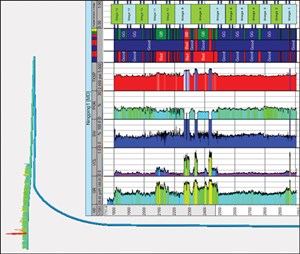
The combination of reservoir quality with completion quality created good-good (GG), good-bad (GB), bad-good (BG) and bad-bad (BB) flags for the well. For example, GG indicates the rock has good hydrocarbon content and is also easy to fracture, making it a good candidate for development. GB suggests the hydrocarbon content is good, but is difficult to fracture, meaning it may be a good target economically, but will be operationally difficult to complete. BG refers to rock that is easy to fracture, but has little or no hydrocarbon content, and should be avoided. BB means there is no hydrocarbon content and the rock is also difficult to fracture.
The combination, referred to as composite quality flag, was then used to develop an overall quality index for staging and perforation placement on the NP1 well, Fig. 2. The objective was to move from the conventional strategy of geometrically, or evenly, spaced stages that may target uneconomical parts of the reservoir, to a tailored approach that targets similar reservoir properties for each stage to achieve a more economically viable scenario.
The well was completed with a 5½-in. cemented liner across the reservoir section. As is customary for most horizontal wells in China, the stage-by-stage hydraulic fracturing operation involved the use of a tubing-conveyed packer, for zonal isolation, and an abrasive perforating technique that cuts holes in the casing to provide access between the wellbore and the reservoir, itself. This is in lieu of the plug-and-perf method commonly used in the U.S., whereby plugs are used for isolation and explosive guns are conveyed downhole for perforation.
Each stage consisted of two perforation clusters placed in areas of similar stress, based on the wellbore geomechanics model, Fig. 3. Sections with poor cement quality, or where there was a risk of perforating across a casing collar, were avoided. Based on field data and experience in the area, the pumping rate for each cluster was increased to more than 3 m3/min. to ensure that proppant could be transported along the fracture length and result in adequate fracture conductivity.
OPTIMIZING JOB DESIGN, EXECUTION
While optimizing the job design through the engineered stimulation process, PetroChina also was able to optimize the job execution and the fluid package, improving the fracturing design as each stage was treated. Based on the Chang 7-1 formation properties, the presence and quantity of natural fissures, potential risk and complications from excessive height growth and the offset-well experience, a hybrid fracturing technique, incorporating the benefits of fracturing fluid cleanup, was selected for the well. Good fracturing fluid clean-up is essential for maximizing well deliverability and effective fracture half-length in low-permeability, low-pressure reservoirs.
The hybrid treatment used a low-viscosity fluid for the pad stage, where fluid is pumped before the sand to open up the rock and create a crack in the formation for the proppant. A higher-viscosity low-polymer, refined guar system with borate crosslinked fluid was used for proppant transport and placement for high fracture conductivity. After each stage, the gel was allowed to break, and the zone was flowed back immediately for clean-up.
Based on local experience, the moderate depths and in-place stress calculations, resin-coated proppants of two mesh sizes were selected to create a high-permeability pathway for the hydrocarbons to flow from the formation with minimal restriction. A stage of 100-mesh sand decreased perforation and/or near-wellbore friction effects, and prevented excessive leakoff to the natural fractures, reducing the risk of a premature screen-out or job termination. The subsequent main stage included 40/70 mesh resin-coated sand to minimize the risk of early bridging and improve transport. The final proppant stages included 20/40 mesh, resin-coated sand to increase near-wellbore conductivity.
To further optimize the treatment designs, microseismic monitoring and real-time fracture modeling updates were performed, Fig. 4. The fracture geometry for each stage was obtained by matching the observed net pressure of the treatment with the mapped fracturing dimensions. By mapping the fracture networks as they were being created, the service was able to optimize the treatment. Based on the microseismic results for a particular stage, including observations of unanticipated fracture geometry, the model was updated, and the treatment for subsequent stages was modified by changing the perforation depth, pumping schedule, fluid type, treatment rate or job size. These modifications ensured fracture coverage of the entire lateral section.
In most cases, the actual volumes pumped were similar to the designs. However, during the pumping of Stage 6, the microseismic results observed during the pad stage indicated that the fracture had opened only in the near-wellbore area. The fracture half-length was shorter than initially designed, due to fluid loss to the surrounding natural fractures. In an attempt to increase the fracture half-length and the reservoir contact area, the pad stage was extended by 415 bbl. The fracture half-length increased, however the pad volume was extended again, by 130 bbl, due to concerns about placement of the main fracturing treatment. The pad volume, including the original design and the two contingency stage volumes, was pumped continuously, with the primary placement of 157,500 lb/m of proppant.
MODIFYING THE TREATMENT
Real-time microseismic measurements also were used to adjust the perforation distance between stages, to achieve good separation between each fracture treatment stage while including the previously acquired information on fracture azimuth and extent. It was important to understand the stress gradient differential within each stage, to ensure that each cluster within each stage was stimulated equally.
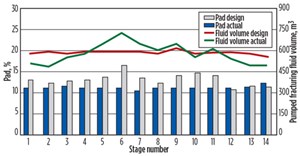
Based on the microseismic data, 11 of 14 states were adjusted during the operation, Fig. 5. After Stage 11 was pumped, the microseismic data were reviewed and used to change the perforation locations for Stage 12, and optimize the distance between adjacent stages. The final microseismic events for Stages 11 and 12 indicated that the perforation spacing avoided overlaps between fracturing treatments and ensured that the lateral section was stimulated effectively with the designed volume of proppant.
After all the adjustments, the final microseismic results of the 14 fracturing stages showed that strong and credible event locations, along with reservoir data, were critical in making real-time intervention decisions. High-stress intervals were avoided when designing the perforation stages to further minimize the risk of operational failure. Perforation placement, regarding the stress profile and the microseismic results, was especially critical for Stages 7–11.
The integrated approach resulted in the NP1 horizontal well producing 755 bopd, an eight-fold increase in IP compared to vertical IP well production. The workflow helped PetroChina to better determine where, when and how to deploy hydraulic fracturing in the lateral section of the well, resulting in increased, and more evenly distributed, stimulated volume along the lateral section. Thus, production and pressure have not declined as quickly as they did for vertical wells completed with a single stage.
Based on the accumulated production profile, the deliverability of the NP1 well remains a constant slope, which is indicative of the reservoir outflow not being exceeded by the well’s flowing condition, with the multiple hydraulic fractures being effective in draining the targeted reservoir area. At approximately 465 days, the slope of the accumulated production changes, but this was due to a well intervention operation, Fig. 6.
In a mature field, where vertical well development has been standard practice, application of the unique workflow for well design and real-time microseismic fracture monitoring in this initial horizontal well helped to gain valuable understanding of hydraulic fracturing and well production. The results showed that a hydraulic fracturing completion strategy can be optimized with integration of a broad range of subsurface information, which is highly beneficial in improving the understanding of fracture behavior.
By incorporating microseismic information in the design process, the multi-discipline team could make better-informed decisions and real-time adjustments to optimize the treatment. The optimized fracture design also relied on reservoir characteristics, taking into account the injection volume and rate, proppant properties and treatment size.
In this case, gathering data early in the horizontal well appraisal process gave PetroChina the opportunity to positively impact the field development, and apply the gained knowledge about model calibration in terms of well spacing and completion scenarios. Additionally, the hydraulic fracturing techniques used for NP1 can be applied to future horizontal wells in other areas of the reservoir. The successful use of fracture treatments, flowback and post-fracture production in the model calibration has paved the way for the simulation model to be used to study production sensitivities for future treatment parameters and well configurations, orientation and spacing. ![]()
ACKNOWLEDGMENT
This article is derived from SPE paper 167062, “An integrated disciplinary approach toward hydraulic fracturing optimization of tight oil wells in the Ordos basin, China.” It was originally presented at the SPE Unconventional Resources Conference and Exhibition-Asia Pacific, Brisbane, Australia, Nov. 11-13, 2013.
- Shale technology: Bayesian variable pressure decline-curve analysis for shale gas wells (March 2024)
- EOR/IOR technology: Advanced shale oil EOR methods for the DJ basin (May 2023)
- The last barrel (April 2023)
- What's new in production (April 2023)
- ShaleTech- Permian shales: Production hits new high amidst talk of looming plateau (April 2023)
- ShaleTech: Marcellus-Utica Shales (February 2023)

